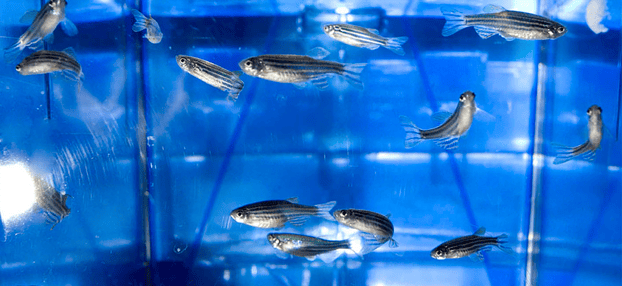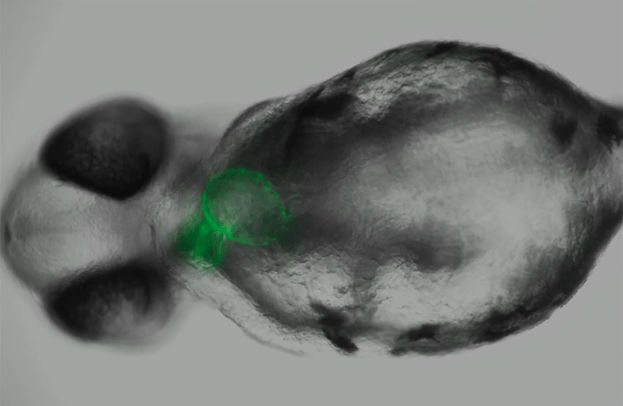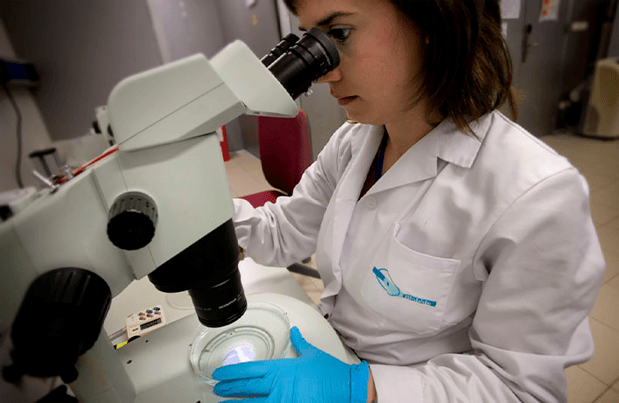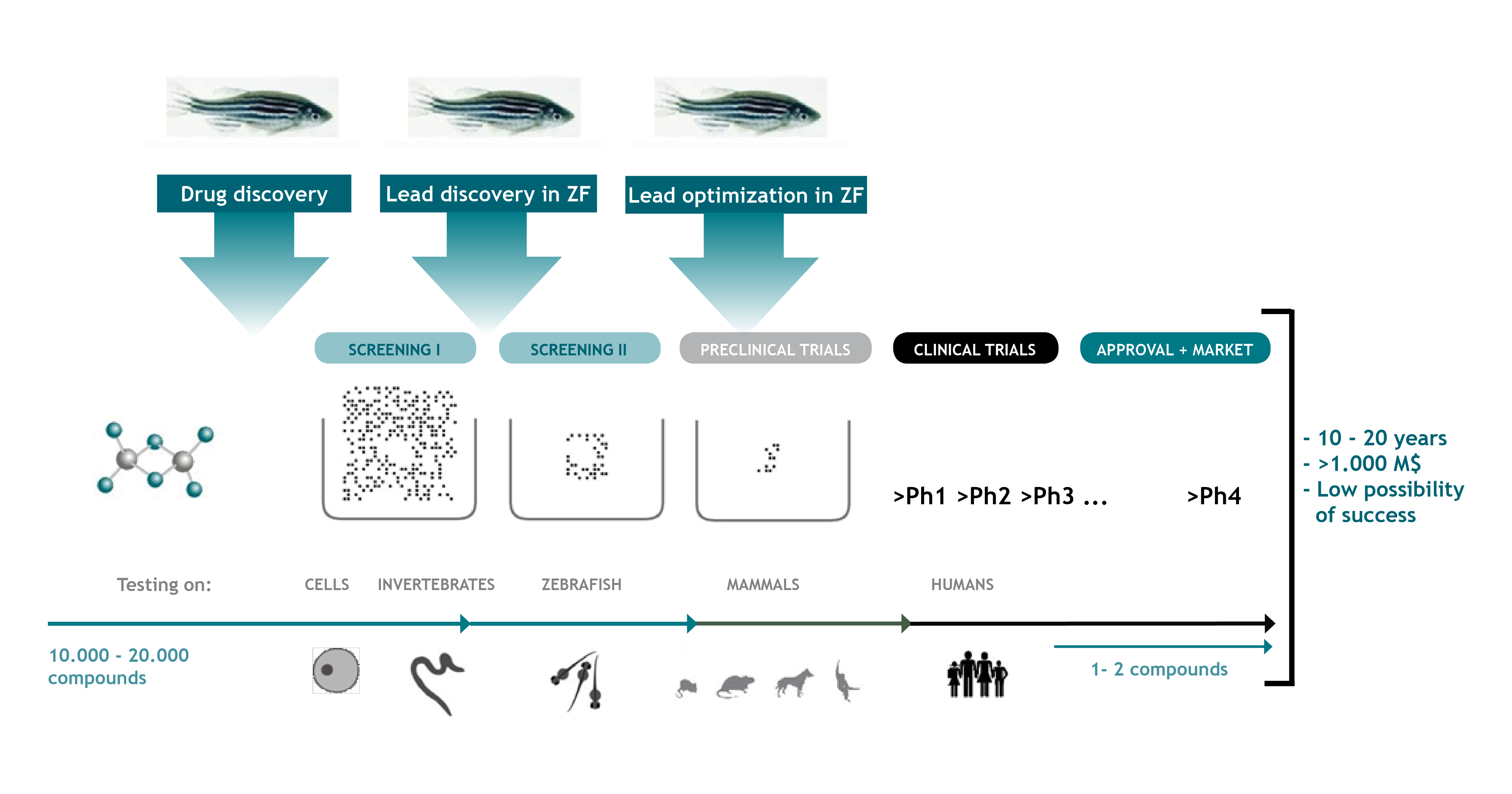As an animal model, zebrafish (Danio rerio) have swum to prominence in the last two decades. A combination of genetic, physical, and economic factors make these little striped fish ideal for various types of research. As scientific research methods evolve, the zebrafish model provides a valid, whole living organism alternative to costly mammalian in vivo methods.
In this article, we’ll review everything you need to know about how Zebrafish are used in research, including what they are, why they’re a good animal model, the 3Rs, the type of research you can conduct using Zebrafish, and much more. Discover what makes these freshwater minnows from South Asia unique and how they’re contributing to scientific breakthroughs in drug toxicology, neurophysiology, disease biology and other areas.

Index:
- Zebrafish Facts in Science: Everything You Need to Know About This Animal Model
- Why are Zebrafish a Good Animal Model Organism?
- Zebrafish and the 3Rs: Reducing Animal Experiments
- What Types of Research are Zebrafish Useful For?
- Zebrafish Development: Embryo and Larvae
- Zebrafish Model Organism in Preclinical Research
- Zebrafish Model Organism in Early Drug Discovery
Zebrafish Facts in Science: Everything You Need to Know About This Animal Model
Animals have been used for research since the time of the ancient Greeks, yet zebrafish hold a number of advantages over other organisms in today’s stringent research environment. From their anatomy to their affordability in High Content Screening (HCS), zebrafish are a leading model in many areas of research.
Let’s cover zebrafish biology and explore how their physical features have made them a leading candidate for multiple fields of study.
Zebrafish Anatomy: What’s so special about zebrafish?
At first glance, these fish don’t appear very special at all. In fact, they’re one of the most common fish in home aquariums. Typically about 6 cm long, zebrafish are silvery and display their namesake blue horizontal stripes the length of their body.
However, as vertebrates, zebrafish have a lot of anatomical similarities with humans and mammals in general: they have two eyes, a brain, a heart, a pancreas, kidneys, and a liver. Zebrafish share most major organs with humans, making them highly translatable for many types of research. Whatsmore, zebrafish are particularly hardy, meaning they are adaptable to various conditions. Some of the zebrafish’s primary advantages as a research model are their externally fertilized and almost complete transparency of embryos. Researchers are able to directly observe effects of test substances, development, and more processes with ease.
Fast Development Process
A female zebrafish produces hundreds of eggs per spawning, which are then fertilized externally. Zygotes typically develop immediately or within 72 hours, with egg division occurring shortly after. Development then rapidly progresses with embryos hatching within 48 to 72 hours, depending on the thickness of the chorion. Around 3 days into its larval stage, zebrafish develop anatomical structures. By 6 days they are usually swimming, and sometimes even start feeding themselves independently.
Such a rapid development lends itself well to research. Researchers are able to test and observe substances and their effects on developing zebrafish in a very short amount of time, ideal for High Content Screenings for small molecules.
Fluorescent and Transparent Zebrafish
Scientists use fluorescent proteins as markers to more easily identify certain processes or reactions during microscopy research. Green fluorescent proteins (GFP), are used to create chimeric proteins which can be expressed in cells, tissues, and whole organisms. Using directed mutagenesis, fluorescence can emit in multiple wavelengths.

Fluorescent proteins are critical to research involving embryonic and larval zebrafish since they are transparent and develop nearly all organs and musculoskeletal structures six days after fertilization. Transparent embryos thus allow researchers to observe organs or tissues marked with tissue specific expressions of fluorescent proteins as they develop. Dozens of transgenic zebrafish lines have been created which express fluorescent proteins in organs, glands, and other bodily structures.
Why are Zebrafish a Good Animal Model Organism?
Genetically, zebrafish are extremely well translatable for the study of human diseases and as test subjects of therapeutic properties. A host of other physical traits and ease of husbandry add to their utility as an animal research model ideal for today’s scientific requirements.
Let’s review some of the reasons why Zebrafish function so well as a suitable animal model organism.
Fluorescent and Transparent Zebrafish
As we mentioned earlier, humans and zebrafish have a surprising number of common features. Our commonality begins with being vertebrates and sharing many of the same organs. Genetically, however, we are much more closely related than we may think. Researchers in the 1990’s discovered that zebrafish have orthologs or counterparts in 80% of human disease-associated genes, and we share 70% of genetic makeup overall. The zebrafish genome has also been fully sequenced to a very high level of quality, resulting in nearly 15,000 mutations created by scientists.
These genetic similarities have made zebrafish assays ideal for mimicking human responses and development during genetic disease, early Drug Discovery, and toxicology research in thousands of studies. They are suitable for both forward and reverse gene processes.
Zebrafish as an In Vivo Model
Another reason zebrafish are a good animal model is that they are an in vivo model. Zebrafish offer a host of advantages over other in vivo models. Husbandry of zebrafish is extremely cost-effective as they are small and live in close shoals, which means housing is space efficient. As mentioned, they are also very hardy and can produce hundreds of offspring at a time. Developing zebrafish can survive on a single well of a standard 384 or 96-well plate, living off of nutrients from their yolk sac. Toxicology can be studied on hundreds of organisms at once using very little amounts of test articles, compared to few mice in the same context. This greatly increases sample size and helps with more accurate statistical analysis.
Transgenic models are easily generated in zebrafish, and their transparency at early stages make them well suited for gene expression assays. Real-time and non-invasive in vivo research using zebrafish as animal models have been popular for decades, and continue to gain traction, for these very reasons. Typical fields include:
- Genetics
- Cell biology
- Environmental toxicology
- Embryology
- Pharmaceutical toxicology
Cost-Effective Solution for Drug Discovery
Finally, another great benefit of the zebrafish as animal models is their cost efficiency. While originally utilized in genetic studies, zebrafish have become a primary player in the Drug Discovery process.
The cost to develop drugs has skyrocketed in recent years and zebrafish are extremely affordable in terms of complexity to cost ratio. They reduce the need for more expensive mammalian models and the related attrition rates. Unexpected results in clinical trials are also very costly in terms of human health and resources. For these reasons, regulations are extremely rigorous concerning predictivity of clinical toxicity, and again, zebrafish are well suited to the task of this High-Content Screening.

Zebrafish and the 3Rs: Reducing Animal Experiments
Along with being a good animal model organism, Zebrafish are also a great option for following the 3Rs of animal research. Movement towards greatly reducing or eliminating animal testing has grown tremendously in recent decades. And many alternative methods are now commonplace, including synthetic organ chips and computational models. However, these alternatives are often insufficient to model whole organism responses. Thankfully, zebrafish have filled this gap quite successfully.
Ethical and more humane animal research methods are a critical concern both publicly and in today’s scientific community. The 3RS of animal research were developed as guidelines for ethical experiments in the 1960’s and continue to shape how research is conducted today. The 3Rs—Replacement, Reduction and Refinement—aim to greatly reduce animal experiments and suffering overall during research.
Zebrafish provide a viable alternative and act as a bridge between in vivo and in vitro methods. Because most zebrafish research is conducted on embryonic fish under 5 days post fertilization (dpf), they meet standards set by the European Commission Directive of 2010. This can lead to a reduction of animals used in later research phases too.

What Types of Research are Zebrafish Useful For?
As you may be realizing, zebrafish are a workhorse as a translatable research model. And there are a multitude of assays in which they’ve shown promise. Developmental and other genetic diseases are extremely difficult to map in humans due to complex combinations of genetic variants. Precision gene editing in zebrafish, however, has been particularly successful.
We will now cover the different types of research that Zebrafish can be used for, including Drug Discovery, Pharma Research, Agrochemical Research, and Cosmetic Research.
Toxicity Assays for Drug Discovery Using Zebrafish
With their transparent ex-utero embryos and ability to absorb compounds through water, it is quite easy to determine if substances or knockdowns cause toxicity in zebrafish. In addition, compounds known to be toxic to humans have been shown to have similar effects in zebrafish, too. Toxicity assays using zebrafish include:
- Developmental / embryo toxicity
- Cardiovascular toxicity
- Hepatotoxicity
- Neurotoxicity
- Nephrotoxicity
- Ocular toxicity
- And others

Efficacy Assays for Drug Discovery using Zebrafish
Efficacy assays have been developed in a range of therapeutic areas that include but are not limited to:
Cancer - Angiogenesis Inhibition:
A common method to detect the capability of a compound to inhibit angiogenesis as part of efficacy pharmacology studies has been developed. Angiogenesis, the development of new blood vessels from existing vasculature, is essential in normal diabetic retinopathy, psoriasis and tumor growth and metastasis.
Neurodegenerative and Rare Diseases:
Several neurodegenerative and neuromuscular rare disease zebrafish models have been generated for target validation as well as for screening of potential new drugs for diseases like Parkinson's Disease (PD), Alzheimer's Disease (AD), Epilepsy, Amyotrophic Lateral Sclerosis (ALS) or Duchenne Muscular Dystrophy (DMD)
Tissue Regeneration:
Zebrafish can regenerate tissue and organs such as the heart, central nervous system, and photoreceptors. In regards to cardiovascular studies in particular, zebrafish are an interesting model to evaluate the effect of test items after injury.
Zebrafish for Pharma Research
Around the globe, researchers in the pharmaceutical industries are using zebrafish in early Drug Discovery studies. Doing High Content Screening of small molecules, scientists are able to develop possible therapeutic compounds at a faster and more cost-effective rate using zebrafish. Drugs in development include treatment for infectious diseases, cardiovascular diseases, neurological disorders, cancers and several rare diseases.
Zebrafish for Agrochemical Research
Toxicity research concerning pesticides such as herbicides, fungicides, bactericides and insecticides has also made use of zebrafish in recent years. Fish are typically used in the embryonic and larval stages to study oxidative stress, developmental toxicity, and neurotoxicity. Between 2012 and 2019, 352 papers were written on the subject showing an increasing usage of zebrafish in agrochemical research, not only for environmental toxicity but also for safety issues.
Zebrafish for Cosmetic Research
Animal testing in the cosmetics industry is highly regulated, particularly in Europe with the introduction of Directive 2010/63/EU. Embryonic and early stage zebrafish, again, offer a viable alternative in this field. Phenotype-based high-rate screenings of skincare products (nanotoxicity) are one such area where zebrafish have shown potential. For example, products which reduce free radical damage to skin from ultraviolet rays are increasingly popular. Zebrafish larvae are a trending and effective option for testing these antioxidant compounds.
Zebrafish Development: Embryo and Larvae
Zebrafish development, including organogenesis, occurs extremely fast. This rapid growth is a primary reason for zebrafish’s application in research.
Below we cover the different stages of Zebrafish development and explain a few key biological facts.
Stages of Embryonic Development of the Zebrafish
Embryogenesis of zebrafish can be divided into eight periods:
Besides developing exceptionally rapidly, zebrafish embryos hold other interesting and useful traits suited to research.

Zebrafish Facts
How Many Cells Does a Zebrafish Embryo Have?
Embryos contain hundreds of cells within 3 hours of fertilization and about 2,000 cells at around 5 hours. Within 48 hours the embryos are in the prime stages.
Zebrafish Embryo Size
A zebrafish embryo is typically about 0.7 mm in diameter and grows to roughly 3.5 mm by the time of hatching.
Zebrafish Embryo Injection
Microinjection practices are frequently used to inject test compounds, dyes, plasmids or RNA for transgenic or mutation generations into zebrafish embryos. There are no membranes between the cell and yolk in stages 1 to 4 of growth, meaning scientists can inject directly and a solution can be easily distributed to the whole organism.
Zebrafish Model Organism in Preclinical Research
Now that you have learned more about the benefits of zebrafish, and their many applications, let’s review how they can be utilized in Preclinical Research.
With stringent regulations on animal testing and research costs on the rise, zebrafish have become an ideal candidate for preclinical research. Their physical traits, especially in the embryonic stages, allow scientists to observe effects of various compounds on a whole living organism in a very short amount of time. Let’s dissect zebrafish’s applications in different areas of preclinical research.
In Vivo vs In Vitro vs Ex-Vivo
As we mentioned earlier, zebrafish are an in vivo model. This is particularly beneficial for preclinical research because they are cost effective and lend themselves to many different research methods.
In vivo refers to testing done on whole living organisms, while in vitro is defined as studies done on cells or tissues outside of a living organism, usually taken from repositories, in a controlled environment such as a test tube. A third option, ex vivo refers to tissue or cells which are harvested or donated from a living organism and minimally altered.
In vitro and ex vivo seem to be very similar but have some distinct differences:
Ex vivo models are:
More complex in cell diversity
Closer to in vivo models
Less reactive to stresses
In vitro models are:
Less complex in cell diversity
More reactive to stresses
Phenotypic Screening
Phenotypic screenings are increasingly accepted as a complementary or alternative technique to early Drug Discovery. Zebrafish have now become a favored model for large scale in vivo phenotypic screenings due to their many physiological and practical advantages. Their rapid development is particularly useful for researchers as it makes these large scale programs very time and resource efficient. These can be categorized into four major types of assay output: morphological, therapeutic, pathway, and behavioral.
Drug Delivery
Phenotypic changes or effects from drug delivery systems can be easily observed in transparent zebrafish embryos. Nanoscale drug delivery systems are of particular interest, and researchers can choose from an array of transgenic and disease zebrafish models to test nanoscale drug delivery systems.
Zebrafish Model Organism in Early Drug Research
Along with preclinical research, zebrafish are also a great option for Early Drug Discovery. Early Drug Discovery is a costly and difficult enterprise fraught with many failures. Fortunately, the use of zebrafish can improve success rates while also reducing costs. Now we will explain the different stages where Zebrafish are crucial in Early Drug Discovery.

High Content Screening
High Content Screening or HCS is a process in Drug Discovery that involves large-scale automated testing of chemicals and biological substances. Zebrafish characteristics make them obvious candidates for this type of research. Creation of sophisticated automated assays has allowed in vivo screens at a scale only previously feasible for cell-based assays.
Hit-to-Lead (H2L)
In early Drug Discovery, increasing the hit-to-lead ratio and decreasing dead end structures is a fundamental objective. Zebrafish are popular animal models in H2L due to their advantages in High Content Screenings in a whole living organism, lessening withdrawal compounds tested, meanwhile reducing costs and development time.
Lead Optimization
Lead optimization is the final stage in the preclinical Drug Discovery process. Maintaining a drug’s target properties, reducing any deficiencies and unnecessary spending are the primary goals. Lead compounds may be altered in this stage to meet a target by further in vivo and in vitro assay assessments. Recent advancements in automated High Content technologies have increased success rates. High Content Screening with zebrafish embryos and larvae in toxicity and safety assays have been highly successful in this regard. They have been specifically useful in predicting reproductive/developmental toxicity, cardiotoxicity, neurotoxicity or neurodevelopmental toxicity and liver toxicity.
Conclusion
The use of zebrafish in scientific research has expanded greatly in recent decades. As we’ve seen, these fast growing fish are remarkably well suited to a range of testing applications. From their physical attributes, genetic translatability and rapid development to their hardiness and cost-efficiency, zebrafish provide an ideal model for research. Even as regulations surrounding animal testing increase, zebrafish embryos have become a viable alternative which still gives responses based on a whole living organism.
With the use of zebrafish, significant discoveries have been made in our understanding and treatment of human disease as well as in potential toxicity of various compounds. And we’ve likely only scratched the surface of how zebrafish can help in future breakthroughs. As animal models, the future looks bright for these striped little fish.





